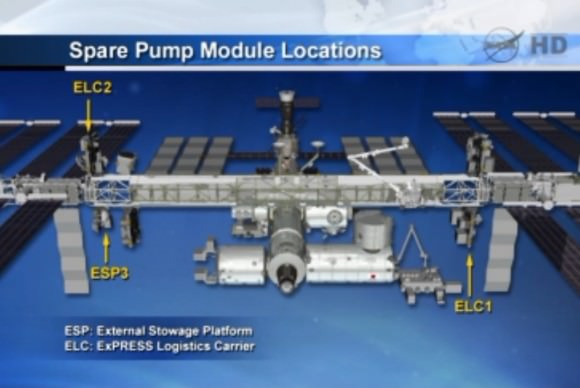While Expedition 38 astronauts Rick Mastracchio and Michael Hopkins get their spacesuits and the Quest airlock ready in case they need to do a spacewalk to fix a cooling problem on board the station, NASA engineers have come up with an alternate proposal that could allow an interim fix from the ground.
A faulty flow control valve inside an external pump caused one of the station’s two main cooling loops to shut down automatically on Wednesday when the loop became too cold. This forced NASA to power down noncritical systems and some experiments as they moved the most needed systems on to a single loop.
After playing with the balky valve for several days, controllers determined it can’t be worked normally. Yet there is another valve nearby that possibly can.
Just “upstream” of the control valve is an isolation valve that possibly can be manipulated to control the temperature, said Kenny Todd, the ISS mission operations integration manager. While the valve is usually either open or closed to do its work, it is possible that it could be positioned at positions in between to warm up the coolant.

“Can we use it as a regulator, if you will, to restrict the flow coming from the radiator and by doing that, that would help to put the temperature in the loop a little warmer,” Todd said in an update broadcast on NASA Television today (Dec. 16) that you can watch in full below.
He added, “We’re taking a valve and using it for a different purpose than we’d originally intended.” This means that software must be adapted to control the valve from the ground, among other things. The hardware vendor (which Todd did not name) has said that theoretically this finer control would be possible.
It’s too early to say if this fix could work in the short term, let alone the long term, which is why Mastracchio and Hopkins are standing by ready to do a spacewalk if need be. NASA has experience with this kind of repair before, most notably in 2010 when astronauts aboard Expedition 24 performed three spacewalks to deal with a broken pump in the same cooling loop. There are three spare pumps aboard station that could swap out the crippled one.
NASA and Mastracchio have both said that the crew is doing fine. The largest scheduling changes are reportedly related to science experiments being suspended, as well as adding in some spacewalk preparation activities. Also, the Cygnus cargo spacecraft’s planned launch has been pushed back at least one day to Dec. 19; last week, NASA said the station’s cooling problem means it is violating certain “commit criteria” for the launch to move forward.
We’ll keep you updated as events warrant.


can we watch NASA fix it live?